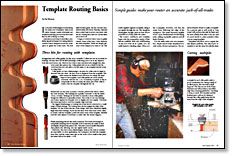
Synopsis: Long ago, Pat Warner discovered a devilishly simple technique for cutting dadoes. In this article, he explains how to cut them with a template and router and a variety of bits. With them, you can mill repeatable patterns and all kinds of joinery. The templates are easy to make, inexpensive, and accurate. He tells how to make precise templates and describes how to build four he uses every day — for butt hinge mortises, for routing small pieces, for repeatable shapes, and for through mortises. He details three bits and their advantages and how to cut multiples. The article also addresses the advantages and disadvantages of three popular router bits used with template work. Warner discusses straight bits and collar guides; pattern bits; and flush-trimming bits. He talks about what tasks he uses these bits for and how well they perform.
In 24 years of self-taught woodworking, I’ve made a lot of mistakes. Early in my career, though, I made a fortunate one. It started a learning process with the router that I’m still working on today.
I had discovered what looked like a devilishly simple technique for cutting dadoes. I used a board clamped across the workpiece to guide the router base. The first dado looked great, but the second wandered visibly off course. That day, I learned that a router base is never concentric with the bit. Turning the router as I cut the dado put a curve in it.
I began to look for better ways to guide routers. Some of the best, I have learned, are with templates. These are simply patterns of the shapes you want to cut. The router registers against a template, using it as a guide through the cut. The simplicity of templates, though, gives no hint of how powerful a tool they make the router.
The router’s usefulness and versatility begin with the tremendous variety of bits that are available. With only a ball bearing on the end of the bit as a guide, you are really limited to detailing edges. When you use a template, however, you free the router from following the edge of the workpiece. The router becomes capable of two more fundamental woodworking tasks: milling repeatable patterns and all kinds of joinery.
You can easily make your own inexpensive, simple and accurate templates for a wide variety of joints and patterns. The initial investment of time to make a template for a precise task is well worth it. Your router will perform that task far faster and far more reliably than other tools can. And it’s much harder to make mistakes when you are using templates.
Templates will allow you to repeat cuts and shapes perfectly, but only if you remember to use the same bit with the same collar at the same depth. The best place to record this information is directly on the template itself.
Make precise templates
The best way to learn the basics of template routing is to make and use some simple templates. But before looking at the practical applications for templates illustrated on these pages, it’s a good idea to start with some general advice about how to make them, what materials to use and the best ways to use them.
From Fine Woodworking #125
For the full article, download the PDF below:
Fine Woodworking Recommended Products

Stanley Powerlock 16-ft. tape measure

Double Sided Tape

Incra Miter 1000HD






















Log in or create an account to post a comment.
Sign up Log in